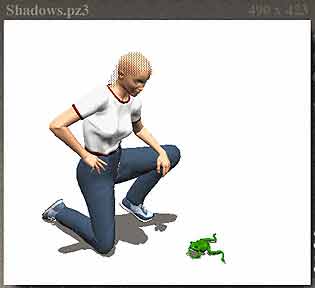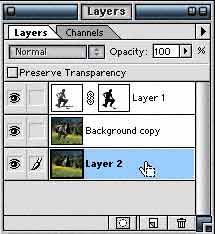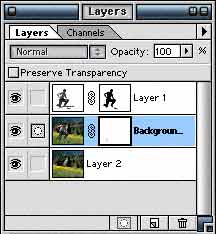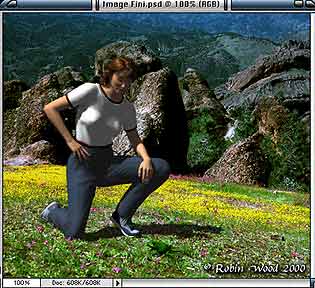
I think it's best to begin with your background picture; but you can begin with the posed figures, and find a background that goes with them. In any case, take care choosing the background. It will work better if it's clear and sharply focused, with distinct shadows; especially for your first few pieces.
Once you have chosen it, arrange and pose your figures in Poser, with the picture handy to refer to. I advise you not to import it yet, since having it in the background is distracting, and will only make the posing more difficult.
 |
Once the shadow is all ruffled and mussed up, like it should be, and follows the contour of the ground (or whatever) you are ready for the next step.
Open the original background photo, and make sure it's exactly the same size as the image you are working with now. (Check Image- Image Size in both, and fix it if it isn't.) Now hold down the shift key, and drag a copy onto Image, just like you did before. In the layers palette, drag the Background layer onto the New Layer button (the little page in the middle on the bottom) to make a new layer called Background Copy. Delete the original background layer by dragging it onto the little trash can at the bottom right. Now drag the layer with the photo, which is Layer 2, underneath the Background Copy layer. |
 |
Click in the Background Copy layer, to make sure you are working there.
Now click the mask button (the little circle in a square on the bottom left in the Layers palette) to make a mask for this layer. Make sure you are working in the mask by clicking on it. The icon to the left of the layer will show the little circle in a square. If it shows a paintbrush, click on the white square to the right of the thumbnail. |
 |
And that's it!
Sign your work, you're done. <g> If you want a few more hints about working with interiors, click here. |
If you have a question, write to me and ask it!
Everything on this site is copyright © Robin Wood; all rights reserved. Please do not use anything without permission. To get permission, write to Robin, and explain what you intend to use it for.